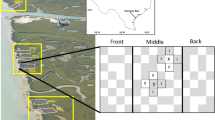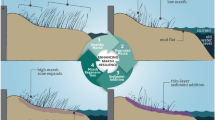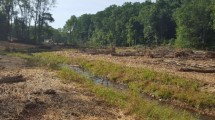Abstract
Coastal wetlands are projected to experience increases in anthropogenic and climatic disturbances, which may alter plant-sediment feedbacks critical for maintaining marsh resilience to sea level. To study the effects of disturbance on ecogeomorphic processes, we examined aboveground plant responses and sediment accretion in three locations relative to the shoreline (low, mid, and high) within a tidal marsh at Grand Bay National Estuarine Research Reserve, Mississippi, USA. This study site was affected by two hurricanes in the fall of 2008, and subsequently burned as part of a controlled experiment in January 2009, permitting examination of the effects of two disturbance types on aboveground plant responses and vertical accretion. Fire and hurricanes affected these response variables differently, with effects dependent on location within the marsh. Fire significantly reduced standing aboveground biomass, and subsequent recovery of vegetation relative to pre-burn levels was faster in low marsh plots nearest to the shore than in high marsh plots closest to the marsh-pine ecotone. Hurricanes introduced sediment to the marsh platform, resulting in greater accretion in low marsh plots that had more standing biomass and higher stem densities than high marsh plots. Collectively, these results demonstrate that disturbances can heterogeneously affect surface soil-building processes in marshes through effects on sediment and organic matter accumulation, which may have important consequences for surface elevation maintenance in coastal marshes.




Similar content being viewed by others
References
Bailey AD, Mickler R, Frost C (2007) Presettlement fire regime and vegetation mapping in Southeastern coastal plain forest ecosystems. In The fire environment-innovations, management and policy conference proceedings. USDA, Forest Service, Rocky Mountain Research Station, Destin
Baldwin AH, Mendelssohn IA (1998) Effects of salinity and water level on coastal marshes: an experimental test of disturbance as a catalyst for vegetational change. Aquat Bot 61:255–268
Barras JA, Bernier JC, Morton RA (2008) Land area change in coastal Louisiana—a multidecadal perspective (from 1956 to 2006). US Department of the Interior, US Geological Survey, Reston, p 14
Bianchette TA, Liu KB, Qiang Y, Lam NSN (2016) Wetland accretion rates along coastal Louisiana: spatial and temporal variability in light of Hurricane Isaac’s impacts. Water 8:1–16
Bickford WA, Needelman BA, Weil RR, Baldwin AH (2012) Vegetation response to prescribed fire in mid-Atlantic Brackish marshes. Est Coasts 35:1432–1442
Boorman LA, Garbutt A, Barratt D (1998) The role of vegetation in determining patterns of the accretion of salt marsh sediment. Geol Soc Lond 139:389–399
Bradley PM, Morris JT (1990) Influence of oxygen and sulfide concentration on nitrogen uptake kinetics in Spartina alterniflora. Ecology 71:282–287
Cahoon DR, Reed DJ, Day JW (1995) Estimating shallow subsidence in microtidal salt marshes of the southeastern United States: Kaye and Barghoorn revisited. Mar Geol 128:1–9
Cahoon DR, Lynch JC, Knaus RM (1996) Improved cryogenic coring device for sampling wetland soils. J Sediment Res 66:1025
Cahoon DR, Ford MA, Hensel PF (2004) Ecogeomorphology of Spartina patens-dominated tidal marshes’ soil organic matter accumulation, marsh elevation dynamics, and disturbance. Coast Estuar Stud 59:247–266
Cahoon DR, Hensel PF, Spencer T, Reed DJ, McKee KL, Saintilan N (2006) Coastal wetland vulnerability to relative sea-level rise: wetland elevation trends and process controls. Wetlands and natural resource management. Springer, Berlin, pp 271–292
Chabreck RH (1981) Effect of burn date on regrowth rate of Scirpus olneyi and Spartina patens. Proc Annu Conf of Southeast Assoc Game Fish Comm 35:201–210
Cherry JA, McKee KL, Grace JB (2009) Elevated CO2 enhances biological contributions to elevation change in coastal wetlands by offsetting stressors associated with sea-level rise. J Ecol 97:67–77
Christiansen T, Wiberg PL, Milligan TG (2000) Flow and sediment transport on a tidal salt marsh surface. Estuar Coast Shelf Sci 50:315–331
DeLaune RD, Buresh RJ, Patrick WH (1979) Relationship of soil properties to standing crop biomass of Spartina alterniflora in a Louisiana marsh. Estuar Coast Mar Sci 8:477–487
DeLaune RD, Nyman JA, Patrick WH Jr (1994) Peat collapse, ponding and wetland loss in a rapidly submerging coastal marsh. J Coast Res 5:1021–1030
Feldman SR, Lewis JP (2005) Effects of fire on the structure and diversity of a Spartina argentinensis tall grassland. Appl Veg Sci 8:77–84
Flores C, Bounds DL, Ruby DE (2011) Does prescribed fire benefit wetland vegetation? Wetlands 31:35–44
Ford MA, Grace JB (1998) The interactive effects of fire and herbivory on a coastal marsh in Louisiana. Wetlands 18:1–8
Friedrichs CT, Perry JE (2001) Tidal salt marsh morphodynamics: a synthesis. J Coast Res 12:7–37
Frost CC (1998) Presettlement fire frequency regimes of the United States: a first approximation. In: Pruden TL, Brennan LA (eds) Fire in Ecosystem Management: Shifting the paradigm from suppression to prescription. Tall Timbers Research Center, Tallahassee, pp 70–81
Gabrey SW, Afton AD (2001) Plant community composition and biomass in Gulf Coast Chenier Plain marshes: responses to winter burning and structural marsh management. Environ Manage 27:281–293
Gabrey SW, Afton AD, Wilson BC (2001) Effects of structural marsh management and salinity on invertebrate prey of waterbirds in marsh ponds during winter on the Gulf Coast Chenier Plain. Wildl Soc Bull 29:218–231
Geatz GW, Needelman BA, Weil RR, Megonigal JP (2013) Nutrient availability and soil organic matter decomposition response to prescribed burns in Mid-Atlantic Brackish tidal marshes. Soil Sci Soc Am J 77:1852–1864
Gedan KB, Silliman BR, Bertness MD (2009) Centuries of human-driven change in salt marsh ecosystems. Ann Rev Mar Sci 1:117–141
Gill JC, Malamud BD (2014) Reviewing and visualizing the interactions of natural hazards. Rev Geophys 52:680–722
Gill JC, Malamud BD (2017) Anthropogenic processes, natural hazards, and interactions in a multi-hazard framework. Earth Sci Rev 166:246–269
Gleason ML, Elmer DA, Pien NC, Fisher JS (1979) Effects of stem density upon sediment retention by salt marsh cord grass, Spartina alterniflora Loisel. Estuaries 2:271–273
Grand Bay National Estuary Research Reserve (2010) Grand Bay NERR Water Nutrient Data: Bayou Cumbest sampling station. http://grandbaynerr.org/research/. Accessed 31 Jan 2010
Gunderson L (2000) Ecological resilience–in theory and application. Annu Rev Ecol Syst 31:425–439
Guntenspergen AGR, Cahoon DR, Grace J, Steyer GD, Fournet S, Townson MA, Foote AL (1995) Disturbance and recovery of the Louisiana Coastal marsh landscape from the impacts of hurricane andrew. J Coast Res 21:324–339
Hackney CT, de la Cruz AA (1981) Effects of fire on brackish marsh communities: management implications. Wetlands 1:75–86
Howes NC, Fitzgerald DM, Hughes ZJ, Georgiou IY, Kulp MA, Miner MD, Smith JM, Barras JA (2010) Hurricane-induced failure of low salinity wetlands. Proc Natl Acad Sci USA 107:14014–14019
Jackson M, Roering JJ (2009) Post-fire geomorphic response in steep, forested landscapes: Oregon Coast Range, USA. Quat Sci Rev 28:1131–1146
Kirwan ML, Guntenspergen GR (2012) Feedbacks between inundation, root production, and shoot growth in a rapidly submerging brackish marsh. J Ecol 100:764–770
Kirwan ML, Megonigal JP (2013) Tidal wetland stability in the face of human impacts and sea-level rise. Nature 504:53–60
Kirwan ML, Murray AB (2007) A coupled geomorphic and ecological model of tidal marsh evolution. Proc Natl Acad Sci USA 104:6118–6122
Kirwan ML, Murray AB, Boyd WS (2008) Temporary vegetation disturbance as an explanation for permanent loss of tidal wetlands. Geophys Res Lett 35:L05403
Kirwan ML, Murray AB, Donnelly JP, Corbett DR (2011) Rapid wetland expansion during European settlement and its implication for marsh survival under modern sediment delivery rates. Geology 39:507–510
Li S, Pennings SC (2017) Timing of disturbance affects biomass and flowering of a saltmarsh plant and attack by stem-boring herbivores. Ecosphere 8:1–9
Liu K, Lu H, Shen C (2008) A 1200-year proxy record of hurricanes and fires from the Gulf of Mexico coast: testing the hypothesis of hurricane-fire interactions. Quat Res 69:29–41
Macreadie PI, Hughes AR, Kimbro DL (2013) Loss of “blue carbon” from coastal salt marshes following habitat disturbance. PLoS ONE 8:e69244
McKee KL, Mendelssohn IA, Hester MW (1988) Reexamination of pore water sulfide concentrationsand redox potentials near the aerial roots of Rhizophora mangle and Avicennia germinans. Am J Bot 75:1352–1359
McKee KL, Cherry JA (2009) Hurricane Katrina sediment slowed elevation loss in subsiding brackish marshes of the Mississippi River delta. Wetlands 29 (1):2–15. https://doi.org/10.1672/08-32.1
McKee KL, Cahoon DR, Feller IC (2007) Caribbean mangroves adjust to rising sea level through biotic controls on change in soil elevation. Glob Ecol Biogeogr 16:545–556
McWilliams SR, Sloat T, Toft CA, Hatch D (2007) Effects of prescribed fall burning on a wetland plant community, with implications for management of plants and herbivores. West N Am Nat 67:299–317
Mendelssohn IA, Kuhn NL (2003) Sediment subsidy: effects on soil-plant responses in a rapidly submerging coastal salt marsh. Ecol Eng 21:115–128
Mendelssohn IA, McKee KL, Patrick WH (1981) Oxygen deficiency in Spartina alterniflora roots: metabolic adaptation to anoxia. Science 214:439–442
Morris JT (2007) Estimating net primary production of salt marsh macrophytes. In: Fahey TJ, Knapp AK (eds) Principles and standards for measuring primary production. Oxford University Press, Oxford, pp 106–119
Morris JT, Sundareshwar PV, Nietch CT (2002) Responses of coastal wetlands to rising sea level. Ecology 83:2869–2877
Mudd S (2011) The life and death of salt marshes in response to anthropogenic disturbance of sediment supply. Geology 39:511–512
National Oceanic and Atmospheric Administration [NOAA] (2008) Tropical cyclone surge probability files. NOAA’s Meteorological development laboratory. http://www.weather.gov/mdl/psurge/download.php. Accessed 1 Dec 2008
Neumeier U, Ciavola P (2004) Flow resistance and associated sedimentary processes in a Spartina maritima salt-marsh. J Coastal Res 20:435–447
Nyman JA, Chabreck RH (1995) Fire in coastal marshes: History and recent concerns. In: Proceedings of the tall timbers fire ecology conference NO. 19. Tall Timbers Research Station, pp 134-141
Nyman JA, Crozier CR, DeLaune RD (1995) Roles and patterns of hurricane sedimentation in an estuarine marsh landscape. Estuar Coast Shelf Sci 40:665–679
Paine RT, Tegner MJ, Johnson EA (1998) Compounded perturbations yield ecological surprises. Ecosystems 1:535–545
Palmer MR, Nepf HM, Pettersson TJR, Ackerman JD (2004) Observations of particle capture on a cylindrical collector: Implications for particle accumulation and removal in aquatic systems. Limnol Oceanogr 49:76–85
Pennings S, Bertness MD (2001) Salt marsh communities. In: Bertness MD, Gaines SD, Hay M (eds) Marine community ecology. Sinauer Associates, Sunderland
Peterson CG, Stevenson RJ (1992) Resistance and resilience of lotic algal communities: importance of disturbance timing and current. Ecology 73:1445–1461
Schmalzer PA, Hinkle CR (1993) Effects of fire on nutrient concentrations and standing crops in biomass of Juncus roemerianus and Spartina bakeri marshes. Castanea 58:90–114
Schmalzer PA, Hinkle CR, Mailander JL (1991) Changes in community composition and biomass in Juncus roemerianus scheele and Spartina bakeri merr marshes one year after a fire. Wetlands 11:67
Shaffer GP, Wood WB, Hoeppner SS, Perkins TE, Zoller J, Kandalepas D (2009) Degradation of Baldcypress—Water Tupelo Swamp to Marsh and Open Water in Southeastern Louisiana, U.S.A.: an Irreversible Trajectory? J Coast Res 10054:152–165
Shepard CC, Crain CM, Beck MW (2011) The protective role of coastal marshes: a systematic review and meta-analysis. PLoS ONE 6:e27374
Slocum MG, Mendelssohn IA (2008) Use of experimental disturbances to assess resilience along a known stress gradient. Ecol Indic 8:181–190
Smith SM, Newman S (2001) Growth of southern cattail (Typha domingensis pers.) Seedlings in response to fire-related soil transformations in the northern Florida Everglades. Wetlands 21:363–369
Smith SM, Newman S, Garrett PB, Leeds JA (2001) Differential effects of surface and peat fire on soil constituents in a degraded wetland of the northern Florida Everglades. J Environ Qual 30:1998–2005
Stumpf R (1983) The process of sedimentation on the surface of a salt marsh. Estuar Coast Shelf Sci 17:495–508
Symbula M, Day FP (2008) Evaluation of two methods for estimating belowground production in a freshwater swamp forest. Am Midl Nat 120:405–415
Tate AS, Battaglia LL (2013) Community disassembly and reassembly following experimental storm surge and wrack application. J Veg Sci 24:46–57
Temmerman S, Moonen P, Schoelynck J, Govers G, Bouma TJ (2012) Impact of vegetation die-off on spatial flow patterns over a tidal marsh. Geophys Res Lett 39:3
Turner MG, Dale VH (2008) Comparing large, infrequent disturbances: what bave we learned? Ecosystems 1:493–496
Turner RE, Milan CS, Swenson EM (2006) Recent volumetric changes in salt marsh soils. Estuar Coast Shelf Sci 69:352–359
Tweel AW, Turner RE (2012) Watershed land use and river engineering drive wetland formation and loss in the Mississippi River birdfoot delta. Limnol Oceanogr 57:18–28
van Coppenolle R, Schwarz C, Temmerman S (2018) Contribution of mangroves and salt marshes to nature-based mitigation of coastal flood risks in major deltas of the world. Estuaries Coasts 41:1699–1711
van de Koppel J, van der Wal D, Bakker JP, Herman PMJ (2005) Self-organization and vegetation collapse in salt marsh ecosystems. Am Nat 165:E1–E12
Walters DC, Kirwan ML (2016) Optimal hurricane overwash thickness for maximizing marsh resilience to sea level rise. Ecol Evol 6:2948–2956
Westman WE (1978) Measuring the inertia and resilience of ecosystems. Bioscience 28:705–710
Weston NB (2014) Declining sediments and rising seas: an unfortunate convergence for tidal wetlands. Estuaries Coasts 37:1–23
White PS, Pickett STA (1985) Natural disturbance and patch dynamics: an introduction. In: White PS, Pickett STA (eds) The ecology of natural disturbance and patch dynamics. Academic Press, New York, pp 3–13
Williams HFL (2012) Magnitude of Hurricane Ike storm surge sedimentation: implications for coastal marsh aggradation. Earth Surf Process Landforms 37:901–906
Acknowledgements
The authors thank University of Alabama students Ryan Cooper, Sarah Masterson, Mason Overstreet, Kevin Richardson, Trey Stevens, and Diane Schneider for assistance with laboratory and field work. We also thank the staff of the Grand Bay National Estuarine Research Reserve for their generous support and field assistance, especially Jay McIlwain and Will Underwood. Comments from Dr. Gregory Starr, Dr. William Platt, and an anonymous reviewer improved the quality of this manuscript. Graphics assistance was provided by David Galinat of the Alabama Water Institute. This research was supported by the National Sea Grant College Program of the U.S. Department of Commerce’s National Oceanic and Atmospheric Administration under NOAA Grant (R/CEH-27), the Mississippi-Alabama Sea Grant Consortium, and the University of Alabama Department of Biological Sciences and New College. The views expressed herein do not necessarily reflect the views of any of those organizations.
Author information
Authors and Affiliations
Corresponding author
Ethics declarations
Conflict of interest
The authors declare that they have no conflict of interest.
Additional information
Publisher's Note
Springer Nature remains neutral with regard to jurisdictional claims in published maps and institutional affiliations.
Electronic supplementary material
Below is the link to the electronic supplementary material.
Rights and permissions
About this article
Cite this article
Braswell, A.E., May, C.A. & Cherry, J.A. Spatially-dependent patterns of plant recovery and sediment accretion following multiple disturbances in a Gulf Coast tidal marsh. Wetlands Ecol Manage 27, 377–392 (2019). https://doi.org/10.1007/s11273-019-09666-3
Received:
Accepted:
Published:
Issue Date:
DOI: https://doi.org/10.1007/s11273-019-09666-3




